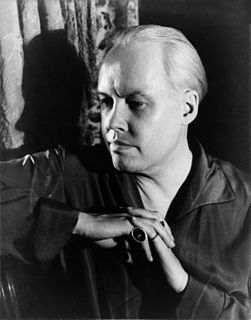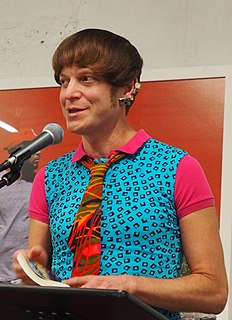
James Avery Hopwood was an American playwright of the Jazz Age. He had four plays running simultaneously on Broadway in 1920.

Gertrude Stein was an American novelist, poet, playwright, and art collector. Born in Pittsburgh, Pennsylvania, in the Allegheny West neighborhood and raised in Oakland, California, Stein moved to Paris in 1903, and made France her home for the remainder of her life. She hosted a Paris salon, where the leading figures of modernism in literature and art, such as Pablo Picasso, Ernest Hemingway, F. Scott Fitzgerald, Sinclair Lewis, Ezra Pound, Sherwood Anderson and Henri Matisse, would meet.

Virgil Thomson was an American composer and critic. He was instrumental in the development of the "American Sound" in classical music. He has been described as a modernist, a neoromantic, a neoclassicist, and a composer of "an Olympian blend of humanity and detachment" whose "expressive voice was always carefully muted" until his late opera Lord Byron which, in contrast to all his previous work, exhibited an emotional content that rises to "moments of real passion".

Carl Van Vechten was an American writer and artistic photographer who was a patron of the Harlem Renaissance and the literary executor of Gertrude Stein. He gained fame as a writer, and notoriety as well, for his 1926 novel Nigger Heaven. In his later years, he took up photography and took many portraits of notable people. Although he was married to women for most of his adult life, Van Vechten engaged in numerous homosexual affairs over his lifetime.

Pavel Fyodorovich Tchelitchew was a Russian-born surrealist painter, set designer and costume designer.

The Autobiography of Alice B. Toklas is a book by Gertrude Stein, written in October and November 1932 and published in 1933. It employs the form of an autobiography authored by Alice B. Toklas, her life partner. In 1998, Modern Library ranked it as one of the 20 greatest English-language nonfiction books of the 20th century.

Mabel Mercer was an English-born cabaret singer who performed in the United States, Britain, and Europe with the greats in jazz and cabaret. She was a featured performer at Chez Bricktop in Paris, owned by the hostess Bricktop, and performed in such clubs as Le Ruban Bleu, Tony's, the RSVP, the Carlyle, the St. Regis Hotel, and eventually her own room, the Byline Club. Among those who frequently attended Mercer's shows was Frank Sinatra, who made no secret of his emulating her phrasing and story-telling techniques.

Mabel Evans Dodge Sterne Luhan was a wealthy American patron of the arts, who was particularly associated with the Taos art colony.
E. Patrick Johnson is the incoming dean of the Northwestern University School of Communication. He is the Carlos Montezuma Professor of Performance Studies and Professor of African-American Studies at Northwestern University. He currently serves as the Chair of the African-American Studies Department at Northwestern University and is a Visiting Scholar at the Annenberg School for Communication at the University of Pennsylvania. Johnson is the Founding Director of the Black Arts Initiative at Northwestern. His scholarly and artistic contributions focus on Performance Studies, African-American Studies and Women, Gender and Sexuality Studies.
Doctor Faustus Lights the Lights (1938) is a libretto for an opera by the American modernist playwright and poet Gertrude Stein. The text has become a rite of passage for avant-garde theatre artists from the United States: La MaMa Experimental Theatre Club, Judson Poets' Group, The Living Theatre, Richard Foreman, Robert Wilson, The Wooster Group, and Production Workshop at Brown University have all produced the piece.
Bravig Imbs was an American novelist and poet as well as a broadcaster and newspaperman.

Mattilda Bernstein Sycamore is an American author and activist. She is the author of two memoirs and three novels, and the editor of six nonfiction anthologies.
Brenda Wineapple is an American nonfiction writer, literary critic, and essayist who has written several books on nineteenth-century American writers.
Laura Aguilar was an American photographer. She was born with auditory dyslexia and attributed her start in photography to her brother, who showed her how to develop in dark rooms. She was mostly self-taught, although she took some photography courses at East Los Angeles College, where her second solo exhibition, Laura Aguilar: Show and Tell, was held. She was well-known for her portraits, mostly of herself, and also focused upon people in marginalized communities, including LGBT and Latino subjects, self-love, and social stigma of obesity.

Yvonne Daunt was a dancer with the Paris Opera in the 1920s. Daunt was made Etoile of the Paris Opera in 1920.
Ulla E. Dydo was a Swiss-born writer, editor and noted Gertrude Stein scholar. She was Professor Emerita at the City University of New York and author of Gertrude Stein: The Language That Rises, 1923–1934.
Autobiografiction is a literary fiction genre that blends autobiography with fiction; it fictionalizes autobiographical experiences, often by altering them, attributing them to fictional characters or reinventing them into other experiences. The concept of autobiografiction was invented by Stephen Reynolds in 1906, and then researched and described in depth by Max Saunders in 2010.
The Four Seas Company was a bookstore and small-press publisher in Boston, Massachusetts. It is remembered today mostly for its publication of the early work of major modernist writers such as William Faulkner, William Carlos Williams, Gertrude Stein, and Yone Noguchi. Four Seas was founded by the young Edmund R. Brown upon his graduation from Harvard College in 1910, and its imprint first appears in 1911. The last book published under the imprint was in 1930, the year the company was absorbed by Bruce Humphries, Inc.
Maia Kobabe is an American cartoonist and author.
Grace Constant Lounsbery was an American author, poet and playwright. She also founded a Buddhism society in France.









